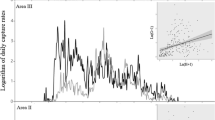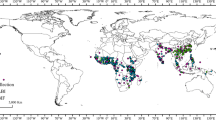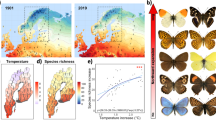Abstract
Northward shifts due to global warming are apparent in various organisms in the Northern Hemisphere such as insects, fish, birds, and plants. However, these findings were mainly reported in Europe and North America. Therefore, such range shifts should be examined in other regions such as Asia to confirm global northward shifts in the Northern Hemisphere. In South Korea, we tested whether the distribution margins of Korean butterflies shifted northward or southward. We used occurrence data from two Korean butterfly atlases (1938-1950 and 1996-2011). The margin (northern or southern) shifts were evaluated using both latitudinal shifts of margin records (direct evaluation) and the intercept shift in the regression equation between the margin shift and the change in occurrence (intercept evaluation). Northern margins of southern species shifted northwards, whereas southern margins of northern species shifted southwards due to habitat enlargement (national reforestation in South Korea). The annual northward shift of northern margins of 10 Korean southern species was 1.6 km for 60 years, which is similar to the Korean isothermal shift (1.5 km per year).





Similar content being viewed by others
Explore related subjects
Discover the latest articles and news from researchers in related subjects, suggested using machine learning.References
Addo-Bediako A, Chown SL, Gaston KJ (2000) Thermal tolerance, climatic variability and latitude. Proc R Soc Lond B 267:739–745
An S-I, Ha K-J, Seo K-H et al (2010) Detection and attribution of climate change: from East Asia to Korea. In: Kim M-K, Lee DK, Lee S et al (eds) Korean climate change assessment report 2010. Ministry of Environment, National Institute of Environmental Research, pp 69–84
Andrew NR, Hill SJ, Binns M et al (2013) Assessing insect responses to climate change: what are we testing for? where should we be heading? Peer J 1:e11. doi:10.7717/peerj.11
Bae JS, Lee KB (2006) Impacts of the substitution of firewood for home use on the forest greening after the 1945 Liberation of Korea. J Korean For Soc 95:60–72
Brommer JE (2004) The range margins of northern birds shift polewards. Ann Zool Fenn 41:391–397
Choi SW (2004) Trends in butterfly species richness in response to the peninsula effect in South Korea. J Biogeogr 31:1–6
Crozier L (2003) Winter warming facilitates range expansion: cold tolerance of the butterfly Atalopedes campestris. Oecologia 135:648–656
Crozier L (2004) Warmer winters drive butterfly range expansion by increasing survivorship. Ecology 85:231–241
Hickling R, Roy DB, Hill JK et al (2006) The distributions of wide range of taxonomic groups are expanding polewards. Glob Chang Biol 12:450–455
Hill JK, Thomas CD, Fox R et al (2002) Responses of butterflies to twentieth century climate warming: implications for future ranges. Proc R Soc Lond B 269:2163–2171
Hitch AT, Leberg PL (2007) Breeding distributions of North American bird species moving north as a result of climate change. Conserv Biol 21:534–539
IPCC (1996) Climate change 1995: the science of climate change. In: Houghton JT, Meira Filho LG, Callander BA, Harris N, Kattenberg A, Maskell K (eds) Contribution of working group I to the second assessment report of the IPCC. Cambridge University Press, New York
IPCC (2007) Climate change 2007: impacts adaptation and vulnerability. In: Parry ML, Canziani O, Palutikof J, van der Linden P, Hanson C (eds) Contribution of working group II to the fourth assessment report of the intergovernmental panel on climate change. Cambridge University Press, Cambridge
Kim S-S, Seo YH (2012) Life histories of Korean butterflies. Sagaejeol Pub. Co., Seoul (in Korean)
Kim S-S, Lee CM, Kwon T-S, Joo HZ, Sung JH (2012) Korean butterfly atlas 1996–2011. Research Note 461. Korea Forest Research Institute, Korea Disabled Human Good Life Pub. Co, Seoul, in Korean
Kiritani K, Yukawa K (2010) Effects of global warming on insects. Japan Rural Education Association, Tokyo
Konvicka M, Maradova M, Benes J et al (2003) Uphill shifts in distribution of butterflies in the Czech Republic effects of changing climate detected on a regional scale. Glob Ecol Biogeogr 12:403–410
Kwon WT (2003) Changes of Korean climate of last 100 years and future prospects. Kor Met Adm News Lett 2:1–8 (in Korean)
Kwon T-S (2014) An empirical test of mid-domain effect using Korean ant richness. J Asia Pac Biodivers 7:e19–e29
Kwon T-S, Kim S-S, Chun JH, Byun BK, Lim J-H, Shin JH (2010) Changes in butterfly abundance in response to global warming and reforestation. Environ Entomol 39:337–345
Kwon T-S, Lee CM, Kim S-S, Sung JH (2012) Distribution change of Korean Butterflies 1938–2011. Research Note 472. Korea Forest Research Institute. Samsung Adcom Pub. Co, Seoul, in Korean
Kwon T-S, Kim S-S, Lee CM (2013) Local change of butterfly species in response to global warming and reforestation in Korea. Zool Stud 52:47–54
Kwon T-S, Kim S-S, Chon JH (2014) Pattern of ant diversity in Korea: an empirical test of Rapoport’s altitudinal rule. J Asia Pac Entomol 17:161–167
McCarty JP (2001) Ecological consequences of recent climatic change. Conserv Biol 15:320–331
Ogawa-Onishi Y, Berry PM (2013) Ecological impacts of climate change in Japan: the importance of integrating local and international publications. Biol Conserv 157:361–371
Parmesan C (1996) Climate and species’ range. Nature 382:765–766
Parmesan C, Yohe G (2003) A globally coherent fingerprint of climate change impacts across natural systems. Nature 421:37–42
Parmesan C, Phyholm N, Stefanescus C et al (1999) Poleward shifts in geographical ranges of butterfly species associated with regional warming. Nature 399:579–583
Pauli H (1996) Effects of climate change on mountain ecosystems – upward shifting of alpine plants. World Resour Rev 8:382–390
Perry AL, Low PJ, Ellis JR et al (2005) Climate change and distribution shifts in marine fishes. Nature 308:1912–1915
Seok DM (1973) The distribution maps of butterflies in Korea. Bojinjae, Pub. Co, Seoul, in Korean
Thomas CD, Lennon JJ (1999) Birds extend their ranges northwards. Nature 399:213
VanDerWal J, Murphy HT, Kutt AS et al (2012) Focus on poleward shifts in species’ distribution underestimates the fingerprint of climate change. Nat Clim Chang 3:239–243
Walther G-R, Post E, Convey P et al (2002) Ecological responses to recent climate change. Nature 416:389–395
Warren RJ, Chick L (2013) Upward ant distribution shift corresponds with minimum, not maximum, temperature tolerance. Global Change Biol 19:2082–2088
Warren MS, Hill JK, Thomas JA et al (2001) Rapid responses of British butterflies to opposing forces of climate and habitat change. Nature 414:65–69
Wilson RJ, Gutiérrez D, Gutiérrez J et al (2005) Changes to the elevational limits and extent of species ranges associated with climate change. Ecol Lett 8:1138–1146
Yamano H, Sugihara K, Nomura K (2011) Rapid poleward range expansion of tropical reef corals in response to rising sea surface temperatures. Geophys Res Lett 38, L04601. doi:10.1029/2010GL046474
Yun J-H, Kim J-H, Oh K-H, Lee B-Y (2011) Distributional change and climate condition of warm-temperate evergreen broad-leaved trees in Korea. Kor J Environ Econ 25:47–56
Zuckerberg B, Woods AM, Porter WF (2009) Poleward shifts in breeding bird distributions in New York State. Global Change Biol 15:1866–1883
Acknowledgments
This study was conducted as part of a research project of the Korea Forest Research Institute (Project FE 0100-2009-01, Effect of climate change on forest ecosystem and adaptation of forest ecosystem). We sincerely thank late Mr. Joo-Myoung Seok and his sister late Prof. Joo-Seon Seok for publishing the first Korean butterfly atlas despite the harsh environment of the period. We thank two anonymous reviewers for their helpful suggestions.
Author information
Authors and Affiliations
Corresponding author
Electronic supplementary material
Below is the link to the electronic supplementary material.
ESM 1
(DOCX 286 kb)
Rights and permissions
About this article
Cite this article
Kwon, TS., Lee, C.M. & Kim, SS. Northward range shifts in Korean butterflies. Climatic Change 126, 163–174 (2014). https://doi.org/10.1007/s10584-014-1212-2
Received:
Accepted:
Published:
Issue Date:
DOI: https://doi.org/10.1007/s10584-014-1212-2




